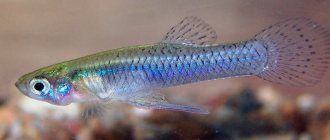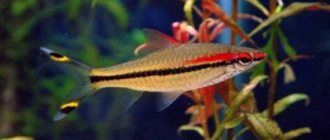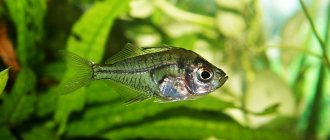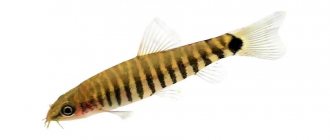Imperial angel: description, reproduction, maintenance, feeding, photo, video
The imperial angel naturally lives in the tropical regions of the Pacific and Indian oceans. These fish can also be found in the Red Sea and near the Hawaiian Islands, where they swim in lagoons and along the slopes of reefs at a depth of up to 35 m. These fish are rightfully considered one of the most beautiful and any aquarist would certainly like to have one in his aquarium. The coloring is very beautiful, and young imperial angels have bright colors and only become more attractive as they grow older. Juveniles are usually dark blue in color with smooth stripes of bluish and white. Adult fish have a blue body color, with horizontal yellow stripes running along the entire body. A dark brown stripe runs through the eyes, and in females it is slightly lighter. The fish's muzzle is light blue. There are no gender differences; the only criterion by which a female can be distinguished from a male is their size; females are slightly smaller than males. Under natural conditions, the size of the male reaches 40 cm, the female – 35 cm. In aquarium conditions, the size of the fish is much smaller. For an aquarium, it is best to purchase small fish, the size of which does not exceed 5 cm, because... These are the fish that are the hardiest.
Content
- Latin name: Pomacanthus imperator
- Russian title: Imperial Angel
- Origin: Indo-Pacific
- Regular sizes: up to 40 cm
- Habitat layer: center
- Acidity pH: 8,2-8,4
- Water temperature: 23-26°C
- Aquarium volume: from 400 l.
T-24-28-30.Rn 8-8.5. Nitrates up to 20 mgl. Angel Emperor Pomacanthus peacefully coexists with representatives of other fish species. Emperors need a spacious aquarium with various shelters in the form of caves, shelters, skerries. In large marine fish aquariums, large angels attract the eye so much that the lack of corals in such marine aquariums is practically not noticeable because... It is the Angel Emperor who is the main object that attracts all attention.
All Angels are mobile and active fish. In a spacious aquarium with many hiding places, the elements of intraspecific and interspecific aggressiveness in the imperial angel are minimized, especially if the neighbors correspond to its size. Typically, the imperial angelfish in a marine aquarium reacts sharply to poor quality food or poor water quality.
The Imperial Angel fish is very intelligent, they are able to recognize their owners and become attached to them; this is expressed in the fact that the emperors willingly communicate in their own way when approaching in their field of vision and willingly take food from their hands, but if they approach a sea aquarium, they immediately hide in a shelter from where they carefully monitor the situation outside the aquarium. In addition, they are also able to make incomparable sounds in the form of grumbling, and this is not a complete list of the advantages of these sea fish, Angel Pomacanthus, which are stunning in their beauty and originality of behavior.
Feeding
This type of marine fish is extremely demanding of high-quality and varied feeding because... The main diet consists of both animal and plant foods with a 50/50 ratio.
Poor quality food and poor water quality can quickly cause “lateral line disease” in the emperor’s angel, this is expressed in the fact that on the sides in the area of the lateral line of the fish, discoloration of the epithelium occurs, which spreads to the head and face of the fish. If measures are not quickly taken to improve water quality and diet, the fish will die; in addition, there is a real danger of diseases such as bulging eyes, as well as fin rot.
There are quite a lot of examples when angels died from stale, not fresh food that was repeatedly defrosted.
BEHAVIOR
A reef aquarium is not suitable for the imperial angelfish. Plant it only in aquariums with fine-pored hard corals, or with soft poisonous ones. This species can be aggressive towards other species. Therefore, purchase not too small and not the largest specimens for your aquarium.
REPRODUCTION
Does not reproduce in aquarium conditions.
IMPERIAL ANGEL: DESCRIPTION, REPRODUCTION, CONTENT, FEEDING, PHOTO, VIDEO.
EIBLE-EIBESFELDT CENTROPIG: CONTENTS AND COMPATIBILITY.
WRASS-PAJAMA: DESCRIPTION AND CONTENTS
SEA URCHNISH: SPECIES, ENEMIES, POISON, HABITAT, PHOTO, REPRODUCE
SWORD - FISH: DESCRIPTION, FOOD, LIFESTYLE, BEHAVIOR, PHOTO
Links[edit]
| Wikimedia Commons has media related to: Pomacanthus imperator (category) |
| Wikispecies has information about Pomacanthus imperator . |
- ^ abcde Pyle, R.; Rocha, L.A. and Craig, M.T. (2010). "Pomacanthus imperator". IUCN Red List of Threatened Species
.
2010
: e.T165862A6151184. DOI: 10.2305/IUCN.UK.2010-4.RLTS.T165862A6151184.en. Retrieved December 21, 2020. - ^ abc Froese, Rainer and Pauly, Daniel, eds. (2019). "Pomacanthus imperator" in FishBase. Version December 2021
- ^ ab "Pomacanthus imperator". Saltcorner!
. Bob Goemans. 2012. Retrieved March 1, 2021. - ^ abcd "Pomacanthus imperator (Bloch, 1787)". Non-native aquatic species
. USGS. Retrieved February 28, 2021. - Daniel Golani; Oren Sonin; Dor Edelist (2011). "Second records of migrants of the Lesepsian fishes Priacanthus sagittarius and Platax teira and the distribution of Tylerius spinosissimus in the Mediterranean Sea". Water invasions
.
6
(1, supplement): s7–s11 (specific reference on page S9). DOI: 10.3391/ai.2011.6.S1.002. - Diane J. Bray. "Pomacanthus imperator". Fishes of Australia
. Museums Victoria. Retrieved March 1, 2021. - Eschmeyer, William N.; Fricke, Ron and van der Laan, Richard (eds.). "Species of the genus Pomacanthus". Catalog of fish
. California Academy of Sciences. Retrieved February 28, 2021. - Christopher Scharpf and Kenneth J Lazara (July 21, 2020). "Order ACANTHURIFORMES (Part 1): Families LOBOTIDAE, POMACANTHIDAE, DREPANEIDAE and CHAETODONTIDAE". ETYFish Project Fish Name Etymology Database
. Christopher Scharpf and Kenneth J. Lazzara. Retrieved February 28, 2021.
History and geography of the product
Representatives of the Lethrinidae family of the perciformes order are one of the most beautiful fish of the ocean and sea habitat. They are known as the genus of imperial bream. The fish lives in the tropical waters of the Indian and Pacific oceans, some species are found in the eastern Atlantic, the Red Sea, the Persian Gulf, New Caledonia, in the waters of Africa and southern Japan.
Letrin feeds on small fish and invertebrates, choosing bottom areas for hunting. In places where the population is widespread, it is a popular food product among the local population. It is considered a tasty delicacy and is appreciated by the natives of Asia and residents of African countries.
Some species of lethrinaceae are grown in cages. In commercial statistics, fish is not reflected as an independent resource, however, despite this, it plays an important role in coastal production where it is found. It is caught with trawl bottom gear, traps, longlines, and gill-type nets. Individuals choose coastal areas, coral reefs, rocks, algae, and stones for habitat. There is no special data on the history of the culinary biography of the Letrins.
Aggressive inhabitants of the Red Sea
In addition to peaceful, safe fish, the waters of the Red Sea also contain dangerous, aggressive species. At the same time, they are not the first to attack, but if they are provoked, you may regret it. As a rule, when blood appears, predators always appear immediately, so following simple rules can help protect a person from unforeseen situations.
That's why:
- Do not touch fish with your hands.
- Do not visit the sea at night.
At the same time, you must always be prepared for the fact that a fish may unexpectedly attack an underwater swimmer.
Types and varieties
Currently, the lethrin family (lethrinus)
includes 27 recognized species.
This is the emperor;
yellowtail; Atlantic; orange spotted; pink ear; striped; refined; pipe; black spot; red muzzle; slim and many others.
Species differ from each other in habitat, size and other characteristics. The coloring of individuals is very diverse. In general, it is bright, catchy, and sometimes extremely contrasting. It can be silver, brown, brown, olive, blue, with spots, with transverse or longitudinal stripes, etc.
Beneficial features
Fish provides significant benefits to the body when consumed regularly. It is able to saturate the body with valuable vitamin PP, fluorine, nickel, chromium, molybdenum, iron, phosphorus, calcium, chlorine, magnesium, potassium, sodium.
The product is useful for overweight people due to its low calorie content. 100 g of fish contains 84 kcal and low fat content ( protein 20.2 g, fat 0.4 g
). Such indicators make lethrina a desirable product on the dietary table.
A considerable amount of fish and phosphorus per 100 g (220 mg)
, as well as potassium
(335 mg)
and sodium
(100 mg)
.
Children need 1200-2500 mg of phosphorus daily, adults need 1500-1800 mg, pregnant and lactating women need 3000-3800 mg. The substance is useful for a growing organism in which bone tissue is just forming, as well as for those who need to normalize the functioning of the kidneys, central nervous system and metabolism. Phosphorus is better absorbed in the presence of calcium in the product. A lack of the substance leads to fatigue, bone pain, irritability and other unpleasant symptoms.
Potassium takes an active part in metabolic processes, blood pressure regulation, removal of fluids from the body, and the functioning of the coronary system. A potassium-containing diet should contain sodium in a 1:2 ratio. Adults need 1100 mg of potassium per day, and children need 16-30 mg of the substance. With its deficiency, disturbances in the functioning of the heart, kidneys, dropsy, ulcers, fatigue, and dry skin are observed.
Sodium is traditionally present not only in fish, but also in salt or soda. It regulates the movement of water in the body, the activity of nerve endings and muscle contraction, and activates food enzymes. An adult needs to take 700-1500 mg per day, children – 300 mg.
When consuming 100 g of lethrin, the body will receive 11.2-16.8% potassium, 2.5-5% sodium, about 18.3% phosphorus of the daily value.
Guitar spotted
Also known as the shark-tail ray. These stingrays have an elongated body, but it is not as strongly flattened as that of other stingrays. They possess two dorsal shanks as well as a posterior shank. The length of the shark-tailed ray can reach 3 meters, and its weight is 227 kg. They lead an extremely calm lifestyle, simply lying on the seabed. Only when they need to eat do they move. They feed on mollusks and crustaceans.
Taste and use in cooking
Letrin has good gastronomic characteristics. It has firm white meat with a meaty texture, similar to chicken with plenty of protein.
What does fish go with?
Herbs/Spices: rosemary, thyme, garlic, lemongrass, coriander, ginger, chilli. Sauces: soy, fish. Fruits: lime, lemon. Drinks: coconut milk, Sauvignon Blanc. Vegetables: potatoes, carrots, onions, tomatoes. Greens: parsley, dill, leek, lettuce, basil. Oil: butter, vegetable, olive, sesame. Dairy products: cheese, sour cream.
How to prepare lethrina?
• Make “sashimi” with greens. • Bake as a filling in shortcrust pastry. • Cook chops with soy sauce. • Grill with spices. • Cook in foil with cheese and vegetables.
In fact, there are many options for preparing lethrin. The fish is low-fat, tender and juicy; its meat can be fried, boiled, stewed, steamed, baked, etc.
Emperor fish
Emperor Angelfish, Pomacanthus imperator (Bloch, 1787)
Size 40 cm Depth 1-100 M
The imperial angel, or imperial pomacanth, or emperor angel (lat. Pomacanthus imperator) is a marine ray-finned fish from the family of angelfish (Pomacanthidae). Body length up to 40 cm. The dorsal fin has 13-14 hard and 17-21 soft rays, the anal fin has 3 hard and 18-21 soft. The color of the sides is blue or blue with closely spaced narrow horizontal and diagonal yellow stripes extending onto the dorsal and anal fins, the front of the head is white, an arched black stripe with a purple tint and blue edges passes through the eyes, a vertically elongated spot of the same color is located above the pectoral fins. The front of the back is green, the upper edge of the dorsal fin and caudal fin are yellow-orange, the pelvic and anal fins are blue with longitudinal brown stripes. Juvenile fish are blue-black with concentric white and blue circles. It acquires adult coloration upon reaching a length of 8-12 cm. It inhabits the inner and outer slopes of coral reefs and deep lagoons, and is found at depths from 1 to 100 m. Bottom fish. Usually seen near ledges and caves. Juveniles mainly stay under ledges and in burrows in shallow reef waters. It feeds mainly on sponges and tunicates, as well as other benthic invertebrates. They protect their rather extensive territory from similar-sized angelfish of their own or other species. Protogynous hermaphrodites. During the breeding season, the male mates with several females living in his territory. Courtship and mating occur at dusk. Eggs and larvae are pelagic. The eggs are round, 0.6-1 mm in diameter. The larvae hatch 1.3-2.6 mm in length, have a large yolk sac, an unformed mouth and unpigmented eyes. As they grow, their body becomes taller and laterally compressed. Life expectancy is up to 14 years. A popular species in the marine aquarium hobby, it is therefore often caught in the wild and exported to the international market, which leads to a decrease in its already low-density populations. Synonyms and popular names: Adlo, Ægte kejserfisk, Äkta Kejsarfisk, Alibangbang, Alibang-bang, Anfouz imbrator, Ange de mer imperial, Angel fish, Angel imperator, Angelfish, Ayam hutan, Badiangon, Baro-baro, Bit, Bluestone asli, Boray -boray, Cá Bướm đế, Cá Chim Hoàng đế, Cous-cous, Dilar, Emperor angelfish, Guingham, Handupholimas, Harabalukokkamas, Holacanthe empereur, Ikan babi, Imperator-Kaiserfisch, Imperial angelfish, Inggu, Kaiserfisch, Kapgo, Keiser-engelvis, Ketang, Klbou, Kokaa, Kulibangbang, Lafidaja Vola, Lati ni daveta, Lebre imperador, Moscht, Ngiungiu, Ngungpaha, Ningúúngú, Paraharaha, Paro-paro, Paru-parang dagat, Pata, Poisson ange imperial, Poisson-ange empereur, Sifisifi, Tapay tapay, Tapel, Taring pelandok, Taring-pelanduk jalur kuning, Tatejima-kinchakudai, Tho, Togougou, Tugou, Tu'u'u-moana, Tu'u'u-nuanua, Tu'u'u-vaolo, Ustniczek cesarski , imperial angel, imperial angelfish, குல்லோகொலிமீன், 主刺盖鱼, 大花脸(幼鱼), 条纹盖刺鱼, 皇后神仙(成鱼), Acanthochaetodon imperator, Acanthochaetodon nicobariensis, Chaetodon imperator, Chaetodon nicobariensis, Holacanthus imperator, Holacanthus nicobariensis, Pomacanthodes imperator, Pomacanthus nicobariensis.
Taxonomy [edit]
The Emperor angelfish was first formally described in 1787 as Chaetodon Imperator
by the German physician and naturalist Marcus Elieser Bloch (1723-1799) with the type of terrain given in Japan.
[7] Some experts place the species in the subgenus Acanthochaetodon
.
The specific name imperator
means "emperor" and reflects the Dutch name
Keyser van Iapan,
meaning "Emperor of Japan", coined by the publisher Louis Renard (c. 1678-1746) in 1719, perhaps reflecting its majestic appearance. [8]
Emperor fish
After my first experience, I now often cook delicious diamondfish. Sometimes I come across very large specimens, and the question arises: what should I use to cook it? Unlike Emperor Domitian, I did not gather the Senate, but solved this problem simply - filleted the fish and baked it in an envelope.
Perhaps not everyone remembers the story of Emperor Domitian and the diamond fish, described in Juvenal’s IV satire. I'll remind you. In Russian sources, the name of the fish is translated as “flounder” (rhombus belongs to this family), but in the original Latin the name of the fish sounds like “rhombum”, which means “rombo” - rhombus fish or turbot. Paraphrase from here:
One day, a fisherman caught a flounder of unprecedented size in a net. What to do with it? Sell it to some rich lover of rare dishes? Now there are many of them in Rome. Just recently, one such rich man paid 6 thousand sesterces for a huge fish. But the fisherman is afraid. Informers are scurrying around everywhere. Just then they will say that the flounder has swum away from the cages belonging to the emperor, and they will drag the defenseless fisherman around the ships. After all, Emperor Domitian tries to take away everything that is of any value from his subjects. It’s better, the fisherman thinks, to give it to the emperor himself. And so he hurries to Rome, to the palace. “Accept the offering,” he says to the emperor, “this flounder was caught for you.” The Emperor graciously accepts the gift. But here’s the problem: the fish doesn’t fit on any dish. Domitian calls the senators to a council. This is a perfect opportunity for him to make fun of them. How much fear they will suffer when a messenger from the emperor calls them to the palace! Everyone will think that some informer has accused him and that expulsion or even execution awaits him. After all, they are all mortally afraid of Domitian: he does not tolerate those who stand out for their nobility, wealth, talent, intelligence or education. He suspects everyone of conspiracies and malicious intent. The venerable elders rush to the palace. Behind them come perfumed and dressed up, Domitian's favorites. They became rich and advanced because they were low flatterers, informers, and slanderers. - Why are we called? - senators ask each other. - Probably important news has been received: maybe a war has started or? some legions rebelled. Finally, everyone is assembled, the council begins. Some are offended that they were disturbed for the sake of flounder. Others sigh with relief. The most clever ones rush to flatter the emperor. “This fish is an omen of your glorious victories and triumphs,” they say. A nobleman known for his gluttony advises ordering the court potters to make a special dish for flounder. His advice is accepted; those gathered were ordered to go home.
I hope that someone will find the instructions for filleting such fish useful. As a result of the operations, 4 fillets are obtained. From the head (removing the gills) and the frame with fins, I cooked a broth, based on which I got a very good seafood risotto, but that was the very next day.
First, you need to arm yourself with a special fillet knife - long, sharp and thin. Unfortunately, I don't have this. The fish was washed under running water and dried with paper towels.
On the “blind” side, I found a place near the head that was softer to the touch, made an incision and carefully removed the insides, washed it, and dried it again.
She made an incision along the ridge, from head to tail. I made a cut diagonally at the head.
I cut the flesh along the line where the fins are attached. Thus, I determined the shape of the fillet and began to separate it from the bones.
She moved from above the ridge, let the knife penetrate deep into the bones, and holding the fillet with her free hand, carefully separated it. I did the same with the second fillet remaining on this side.
Then I turned the fish over and separated the two remaining fillets.
Then I freed each piece of fillet from the skin. Place the fillets on a cutting board, skin side down. I made an incision on the narrow side so that the knife was above the skin at a slight angle. Holding the loose end of the skin with my free hand, carefully moving the knife at an angle, I separated the fillet from the skin.
I did this operation with all four parts. Then I cut them into pieces. I laid out the fish pieces on baking paper, salted and peppered them, sprinkled them with olive oil, added lemon slices without zest and a sprig of myrtle (I found it while walking), maybe rosemary.
She tightly packed an envelope of baking paper and placed it in the oven for 20 minutes at 180 C.
Behavior
Imperial angels willingly settle near the slopes of coral reefs and in protected lagoons at a depth of up to 25 m. Sometimes they inhabit deeper lagoons up to 100 m deep. The occupied area of the fish is actively protected from relatives and representatives of related species.
One angel can live in one area or 2-3 individuals (a male with his harem) can live peacefully. Hunting grounds can cover an area of up to 1000 square meters. m. With a larger number, conflicts between them are inevitable.
Adult fish drive away trespassers with rather loud clicking sounds made using their swim bladder.
The diet consists of benthic invertebrates, sponges and tunicates. From time to time, the fish also eat various types of algae and ingest small amounts of silicon oxide to improve digestion.
During the spawning period, a pair of imperial angels swims at dusk from the usual reefs and circles in surface waters near sea currents. Fertilized eggs are carried away by the current, and the fish return to their native reefs.
The size of the eggs does not exceed 0.7-1 mm in diameter. From them larvae hatch, up to 2.6 mm long and with a large yolk sac.
The larvae lead a pelagic lifestyle. Gradually their body shape changes and they sink to the seabed.











